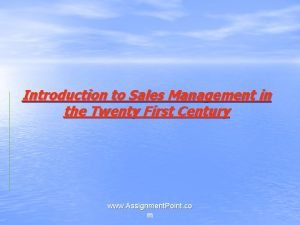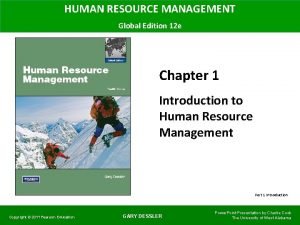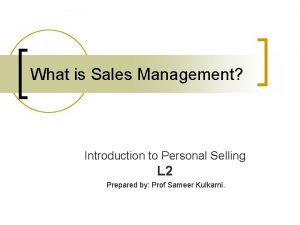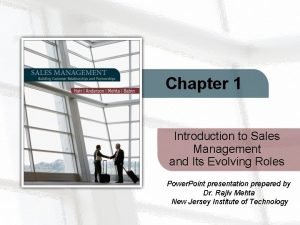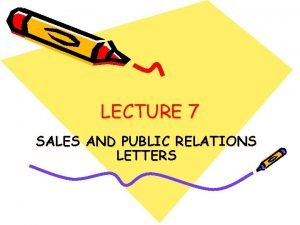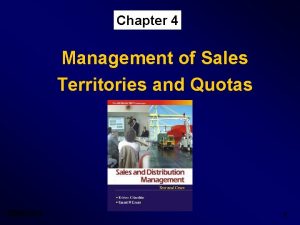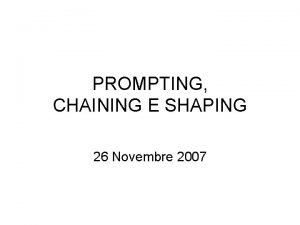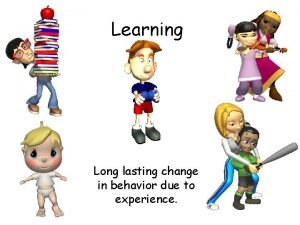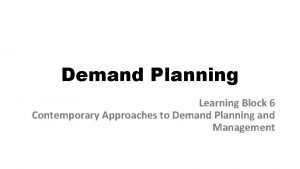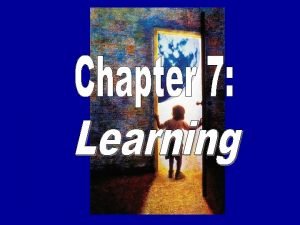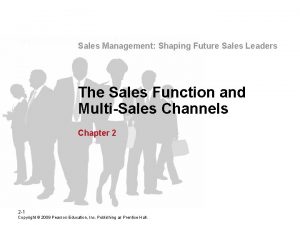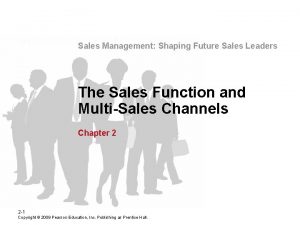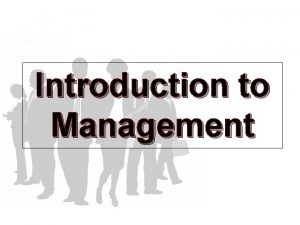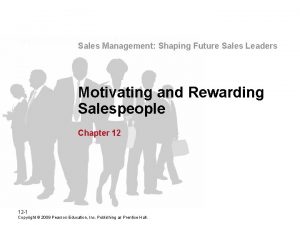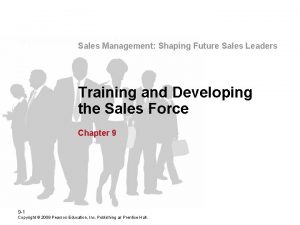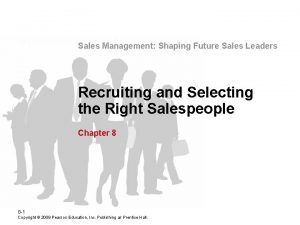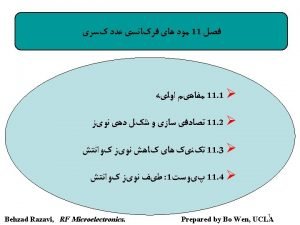Sales Management Shaping Future Sales Leaders Introduction to














































- Slides: 46

Sales Management: Shaping Future Sales Leaders Introduction to Sales Management Chapter 1 1 -1 International Sales Management

Managing Sales Force Is Important § Sales positions are the hardest jobs to fill. § Sales is also one of the most expensive activities a company undertakes. § Sales consumes are more than 20% of a firm’s revenue. 1 -2 International Sales Management

$$$ § As a career opportunity, starting in sales is an excellent choice. § Sales starting salaries are about 20% higher than other marketing positions. § Many CEOs get their start in sales. § Sales managers earn more than managers in other areas. § Sales jobs predicted to grow at a faster rate than other professions. 1 -3 International Sales Management

Establishing the Parameters of the Firm’s Strategy: The Mission Statement § A strategy is a plan designed to accomplish a mission. § A mission is a set of objectives. § Most companies tend to think of missions in longer terms rather than as a single campaign. § Often companies summarize their goals in what’s called a mission statement. 1 -4 International Sales Management

Vision to Mission Statement Objectives Goals Philosophies Product or Service Primary Market Survival, Growth, Profitability Managerial Philosophy Level of Quality Social Responsibility 1 -5 International Sales Management

Establishing the Parameters of the Firm’s Strategy: The Mission Statement § Mission statements should serve to; § Inspire the members of an organization § Give purpose to their actions § Guide their decision-making § A good mission statement also serves as a standard against which the decisions and actions employees take can be compared to ensure that they are the ones for the organization. § Once the mission’s objectives are set, strategy can be created. 1 -6 International Sales Management

Sample Mission Statements § Coca-Cola § Southwest Airlines 1 -7 International Sales Management § Everything we do is inspired by our enduring mission: § To Refresh the World. . . in body, mind, and spirit § To Inspire Moments of Optimism. . . through our brands and our actions § To Create Value and Make a Difference. . . everywhere we engage § The mission of Southwest Airlines is dedication to the highest quality of Customer Service delivered with a sense of warmth, friendliness, individual pride, and Company Spirit

The Strategy Hierarchy § A firm’s corporate strategy encompasses plans and goals for the entire organization. § The corporate strategy will also address questions such as what markets and sourcing options company should engage. § Ex: hire sales force vs. use distributors § Ex: outsource mf and focus internally on marketing § Once a company’s strategy is formulated, it is then communicated to the firm’s various business units –marketing, sales, manufacturing, and so forth– create their plans to support corporate strategy 1 -8 International Sales Management

The Strategy Hierarchy § The flow of the strategy from the organization level to the unit level is called the strategy hierarchy. § The firm’s marketing plan is likely to precede its sales plan. § Marketing and sales work together to create an overall marketing strategy. 1 -9 International Sales Management

The Strategy Hierarchy Corporate Strategy Marketing Strategy Sales Strategy 1 -10 International Sales Management

Creating a Marketing Strategy Markets § What markets do we serve with what products? Relationships § What types of relationships do we form and with whom? Investment § What level of investment will be required, and how will we locate and allocate the needed resources? Objectives § What are the detailed objectives and action plans? 1 -11 International Sales Management

What Markets Do We Serve with What Products? § In certain situations, the product defines the company. § For ex; Xerox was built around xerographic technology. § At other times, a natural market such as a geographic area might define a company. § An example might be steel mills in Pennsylvania, located near iron ore and coal deposits needed to manufacture steel. § Yet, when market conditions changed, both Xerox and the mills had to carefully consider what markets they wanted to serve and with what products. 1 -12 International Sales Management

What Markets Do We Serve with What Products? § Find a sustainable competitive advantage, something that gives a company an edge in the market over time. § To achieve a competitive advantage, you need expertise, expertise technology or a patent that is difficult for others to copy. 1 -13 International Sales Management

Product-Market Grid 1 -14 International Sales Management

What Types of Relationships Do We Form and with Whom? § Strategic plan considers network of relationships § § Investors, potential investors, bankers Suppliers Personnel sources Regulatory agencies § Relationship with customers is most important aspect of its relationship strategy. § Customers’ lifetime value is worth more than the average single purchase 1 -15 International Sales Management

Customer Relationship § Today, more firms are in the business of providing services. § Called the service dominant logic, the idea is that being in business is essentially about serving the needs of others. § Whether or not the company actually makes a tangible product, the real advantage lies in how the organization serves its’ customers needs § Therefore, all companies, no matter what line of business they are in, should try to gain a service advantage. § A service advantage is often a function of the quality of relationships a firm has with its customers.

Customer Relationship Management (CRM) Customer Relationship Management § Identifying and grouping customers in order to develop an appropriate relationship strategy § So the organization can acquire, retain, and grow the business 1 -17 International Sales Management

Customer Relationship Management (CRM): Key Terms § CRM: the process of identifying and grouping customers in order to develop an appropriate relationship strategy so that the organization can acquire, retain, and grow the business. § Sales and marketing teams are responsible for CRM § Customer acquisition strategy: plan to obtain new customers § Customer retention strategy: plan designed to keep customers § Growth strategy: plan designed to increase sales to the same customers 1 -18 International Sales Management

Customer-Centric Sellers § CRM technology helps firms become more market- or customer-oriented § Firms practice a market orientation when business processes and functions are aligned to maximize effectiveness in the marketplace § A market-oriented selling firm places the buyer at the center of all of the strategic decisions 1 -19 International Sales Management

Customer Lifetime Value (CLV) Strategies § The goal for sales representatives and their managers is to establish and maintain mutually beneficial, long-term relationships with their most profitable customers. § Companies that follow a CRM strategy work to provide distinct service levels to customers based upon their expected customer lifetime value (CLV). 1 -20 International Sales Management

Planning Sales Strategy Based on CLV 1 -21 International Sales Management

Planning Sales Strategy Based on CLV High Lifetime Earning Value Low % of Purchase Share High % of Purchase Share Frequent sales force visits Constant sales force interaction Monthly visits Weekly visits Direct mail/telemarketing Optimal contact: biweekly Optimal contact: weekly High potential customer value Highest customer value Extended sales force visits Infrequent sales force visits Yearly intervals Six-month intervals Direct mail/telemarketing Optimal contact: quarterly Optimal contact: bimonthly Low value customer Low potential customer value 1 -22 International Sales Management

Computing CLV

The Stages of B 2 B Customer Relationship Management 1 Up-sell / cross-sell to existing customers 2 Manage customer relationships to earn higher profits 3 Offer customized solutions to most profitable buyers 1 -24 International Sales Management

What Level of Investment Will Be Required, and How Will We Allocate the Needed Resources? § Another important aspect of strategic planning involves finding the capital, or resources necessary to accomplish the firm’s plan. § This includes money, money human or social capital § Human capital refers to the people that make up an organization. § For ex, a firm that has more highly skilled employees will have greater degree of human capital. § Social capital refers to the ties that the firm has with others. § Social capital is who owes you a favor or who can be asked a favor.

What Level of Investment Will Be Required, and How Will We Allocate the Needed Resources? § Human capital decisions include: § Determining number of salespeople § What skills and experience they must have § What training they require § Other decisions include: § Whether to hire telephone prospectors or to outsource § Who handles customer service (a sales rep or a customer service rep) 1 -26 International Sales Management

What Are the Detailed Objectives and Action Plans? § SMART format for establishing objectives S pecific Measurable A chievable, yet challenging R ealistic T ime-based 1 -27 International Sales Management

What Are the Detailed Objectives and Action Plans? § SMART objectives can motivate managers and salespeople alike. § These objectives can also be used to hold managers accountable. § Milestones, or important short-term objectives, can help mark the company’s progress toward achieving its objectives. 1 -28 International Sales Management

Selling Approaches § A company should have a standard sales method. § However, because customers make buying decisions differently, there will obviously be variations in the selling techniques successful salespeople use. § Research shows that there are four basic models of selling: § § Transactional Problem solving (consultative) Affiliative Enterprise selling 1 -29 International Sales Management

Selling Approaches Transactional § Finish sale as quickly and as easily as possible § Key to success is making as many calls as possible to as many people as possible Affiliative § Based on the friendship between the salesperson and the individual buyer § Identify and solve a client’s problems Problem Solving § Also called needs-satisfaction selling or or Consultative problem/solution selling Enterprise 1 -30 International Sales Management § Business-to-business (B 2 B) concept § Based on not only person-to-person relationships but on company-to-company relationships

The Selling Approach: 8 Steps 1 -31 International Sales Management

Prospecting § Prospecting involves identifying potential customers for a particular product or service. § A prospect is a MAD buyer, someone with § the Money to spend, § the Authority to buy, § the Desire to buy it. 1 -32 International Sales Management

Pre-Approach § During Pre-Approach, the salesperson tries to learn everything he can about the account. § Can take a significant amount of time. § Preperation signals that the salesperson is knowledgeable, competent, and cares about the customer. 1 -33 International Sales Management

Approach § Approach: salesperson asks buyer to commit to a meeting § Opening statement must get buyer’s attention. § A good opening statement causes the buyer to focus on the salesperson. 1 -34 International Sales Management

Needs Identification § Needs identification: salesperson confirms prospect is MAD (Money, Authority, Desire) § Comprised of 3 elements; 1 Questioning 2 Identification 3 Pre-commitment 1 -35 International Sales Management

Presentation § Presentation: salesperson describes product and how it meets buyer’s needs Feature Evidence Benefit Agreement 1 -36 International Sales Management

Handling Objections § Objections: reasons a buyer offers to not buy your product § Can occur at any time § Salesperson should find out root of concern and resolve it 1 -37 International Sales Management

Closing the Sale § Close: when salesperson asks buyer for the sale § Good close § Reinforce decision to buy § Confirm implementation schedule § Thank the buyer § Ask for referral 1 -38 International Sales Management

Implementation/Follow-Up § Follow-Up: After delivery, ensure that the customer has good experience with product § Training, service, policies and procedures 1 -39 International Sales Management

Selling Process vs. Selling Approach Selling Process Transactional Prospecting Affiliative Consultative Enterprise 1 -40 International Sales Management Closing Presenting

Selling Process vs. Selling Approach § The selling process is a constant cycle of prospecting, presenting, and closing. § Whether the model is transactional, transactional consultative, consultative affiliative, affiliative or enterprise, enterprise the basic process is similar. § In a transactional situation, situation little time is spent on needs identification. The emphasis in the selling process is on the presentation and a key to being successful is to make as many presentations as possible. 1 -41 International Sales Management

Selling Process vs. Selling Approach § Affiliative selling, selling may not require a long needs identification process. Yet, there is a relationbuilding process that is ongoing, within which the selling process takes place. More emphasis is given to follow-up because it is during this step that the relationship with the customer is built. § Consultative selling emphasizes the needsidentification stage. The complexity of the buyer’s situation will make it necessary for the salesperson to spend a great deal of time, relatively speaking, on understanding the situation and needs. 1 -42 International Sales Management

Selling Process vs. Selling Approach § With enterprise selling, selling the seller will engage in consultative, affiliative, and transactional selling at different times and with different products. The result is that the emphasis shifts, shifts depending on the situation within the account. 1 -43 International Sales Management

Ethics in Sales Management: Maintaining NCR’s Ethical Sales Culture We … recognize that selling only works when everything is right for the customer—when we deliver value —Rick Makos President, NCR-Canada 1 -44 International Sales Management

Questions and Problems 1. Estimate your lifetime value to Starbucks (or a fast-food restaurant). Then estimate your lifetime value as a car owner. Is the concept of lifetime value of equal importance to your car dealer as it is to Starbucks? What is the growth strategy of both? 2. Examine the mission statements in the chapter. Then go to the Web site of your university and find your university’s mission statement. Assess your university’s mission statement. 1 -45 International Sales Management

Questions and Problems 3. “Nothing happens until a salesperson sells something. ” This statement has been around for decades. What does it mean? How does it relate to the strategy hierarchy. 4. “I want to be the best student this university has ever had. ” Is that a SMART goal? If not, rewrite that statement into the SMART format. 1 -46 International Sales Management
 Future sales leaders
Future sales leaders Future perfect form
Future perfect form Esercizi future continuous e future perfect
Esercizi future continuous e future perfect Shaping rotary's future
Shaping rotary's future Future leaders exchange
Future leaders exchange Ukri future leaders fellowships round 7
Ukri future leaders fellowships round 7 Ukri future leaders round 7
Ukri future leaders round 7 Future health leaders
Future health leaders Future business leaders of america definition
Future business leaders of america definition What is the fbla pledge
What is the fbla pledge Introduction to sales management
Introduction to sales management Demographic trends affecting human resource management
Demographic trends affecting human resource management Sales management introduction
Sales management introduction Introduction to sales management
Introduction to sales management Contoh sales management
Contoh sales management Future perfect
Future perfect Facts about tenses
Facts about tenses Future continuous future perfect exercises
Future continuous future perfect exercises Future nurse future midwife e learning
Future nurse future midwife e learning Used to show interrupted action in the past
Used to show interrupted action in the past Present continuous tense of plan
Present continuous tense of plan Future tenses summary
Future tenses summary Future plans and finished future actions
Future plans and finished future actions Future perfect x
Future perfect x Future continuous and future perfect objasnjenje
Future continuous and future perfect objasnjenje Sales force structure example
Sales force structure example Discuss the nuances of sales letters.
Discuss the nuances of sales letters. Sales potential vs sales forecast
Sales potential vs sales forecast Pengertian sales force
Pengertian sales force Clover leaf routing plan
Clover leaf routing plan Differenza tra shaping e chaining
Differenza tra shaping e chaining Shaping process
Shaping process Characteristics of polymers
Characteristics of polymers Shaping 2030
Shaping 2030 Sculpture is created by shaping or combining the materials
Sculpture is created by shaping or combining the materials Esempi di prompting
Esempi di prompting Precision fluency shaping program review
Precision fluency shaping program review Particulate processing adalah
Particulate processing adalah Palo alto traffic shaping
Palo alto traffic shaping Variable ratio schedule of reinforcement
Variable ratio schedule of reinforcement Puzzle box thorndike
Puzzle box thorndike Classical and operant condition
Classical and operant condition An event that leads to lasting change
An event that leads to lasting change Fluency shaping tekniği
Fluency shaping tekniği Shaping psychology
Shaping psychology Demand sensing and shaping
Demand sensing and shaping Shaping psychology definition
Shaping psychology definition










